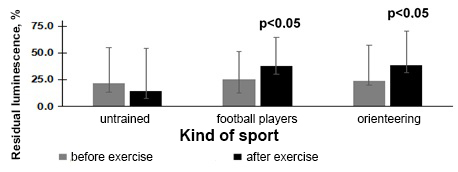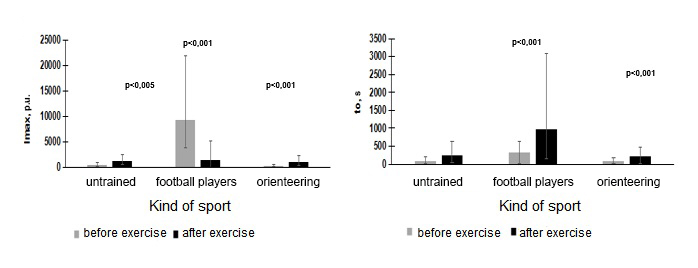Benefits of biophysical tests of saliva for athletic functionality rating tests
ˑ:
A.M. Vyshedko1
PhD L.V. Stepanova1
Dr.Biol., Associate Professor O.A. Kolenchukova1, 2
Dr.Biol., Professor V.A. Kratasyuk1
1Siberian Federal University, Krasnoyarsk
2Separate Division of Institute of Biophysics SB RAS, Krasnoyarsk
Keywords: elite sports, saliva, bioluminescence test, chemiluminescence test, residual luminescence, antioxidant activity rate.
Introduction. Improvement of physical training systems requires individualization of the training process, which may be efficient enough only when supported by objective tests to rate the bodily responses to physical workloads [1]. Success in modern professional sports is impossible unless supported by the newest medical/ biological findings and technologies in the health rating and forecast domains, with a special role played by the modern biophysical research of the cellular- and molecular-level biological processes [5, 6-8]. Biophysical tests can be used to assess violations in the adaptive potential of the body, leading to immune suppression under the influence of intense training loads [4, 8].
The use of non-invasive methods of health monitoring is also of current interest. Saliva is easy to study and is suitable for diagnostic purposes, as it contains specific soluble biological markers (biomarkers). The use of saliva as a biological fluid that is easy to collect removes restrictions on the frequency and availability of measurements, makes it possible to create a convenient tool for the daily work of both coaches and doctors in sports medicine, as well as individual monitoring of the bodily responses to physical workloads [2, 7].
Objective of the study was to assess the possibility of using bioluminescence and chemiluminescence tests as a non-invasive method of assessing the functional state of athletes under physical loads.
Methods and structure of the study. The experiment was carried out at the Institute of Physical Culture, Sport and Tourism of Siberian Federal University. Sampled for the study were the professional athletes (football players, n=10; orienteering, n=17) of different skill levels (Class I, CMA and MS, WCM, HMS) versus the untrained students (Control Group), with the groups being similar in the age (19±2 years old) and gender compositions. The study was conducted in the process of training and run from September through November 2017. All subjects performed physical loads of similar intensity (with their HR ranging between 65-75% of its resting value) in the aerobic mode for 90 min. Every subject gave his/ her informed consent for the tests.
Saliva was the study object. It was sampled by spitting in a test tube prior to and after physical trainings. The samples were centrifuged (Eppendorf Centrifuge 5810 r, Germany) for 15 minutes at the speed of 5,000 rounds per minute. A supernatant was used for analysis. The bioluminescence and chemiluminescence tests were carried out on a tablet luminometer (Berthold Technologies, Germany).
The bioluminescence saliva tests were carried out using a bioluminescent enzymatic method [6]. The biological test rate was determined by the value of residual luminescence (T, %) of the bienzymatic test system.
H2O2-luminol-dependent chemiluminescence was used to rate antioxidant activity [3]. Catalase activity was analyzed based on such indicators as t0 and tmax indicating the time of onset of the chemiluminescent reaction in saliva when exposed to H2O2 and its peak activity; Imax - maximum intensity of chemiluminescent reaction; Smax - maximum chemiluminescent curve area; U - chemiluminescent curve decrease rate.
Results and discussion. The bioluminescence tests found that, before exercise, the level of residual luminescence of the enzymatic system in the athletes was increased relative to the Control Group (Fig. 1). The enzymatic system bioluminescence was more significantly reduced by the saliva of the untrained students rather than that of the athletes. In the Reference Group, the changes in the enzymatic composition of saliva occurred after exercise led to a decrease in the residual luminescence index, in the group of athletes it increased.

Fig. 1. Residual luminescence in athletes’ saliva before and after exercise.
Note. Here and Table 2: untrained – Reference Group; p - significance of differences relative to the Reference Group.
Therefore, the physical loads contributed to the changes in the athletes’ salivary composition, which increased the enzymatic system activity.
The analysis of changes in the activity of the enzymatic system under the influence of saliva revealed the differences between the athletes of different sports qualifications. After exercise, the athletes belonging to the 1st senior category (p<0.05) were found to have a negative change in the residual luminescence, and those qualified CMS, MS and WCMS - a positive change (p<0.05), which differed significantly from the group of untrained students.
Therefore, the negative changes in the residual luminescence of the enzymatic system, revealed after exercise, corresponded to the group of students and athletes belonging to the 1st senior category, which is typical for the low level of adaptation to increased physical loads. A positive value of the residual luminescence was typical of the highly skilled athlete.
The study of the chemiluminescence activity in the athletes’ saliva after exercise revealed a decrease in the chemiluminescence indices t0, Imax, Smax and Tmax as opposed to the Reference Group (see Table).
Table 1. Antioxidant activity rates after physical loads
|
Indicators |
Students |
Athletes |
|
t0 |
243.0 (211.0;401.0) |
116.0* (106.0;116.0) |
|
Imax |
1193.0 (708.0;1278.0) |
174.5* (158.0;190.0) |
|
Smax |
39734 (25438;56430) |
7662* (7057;8234) |
|
Tmax |
16.1 (16.1;16.1) |
116.0* (106.0;116.0) |
Note. * statistically significant difference between the chemiluminescence test rates in the Reference Group athletes at p<0.001.
It can be assumed that the metabolic processes in the athletes’ body are reorganized under the influence of physical loads, which leads to the improvement of the athletes’ working efficiency with low energy costs.
The analysis of the chemiluminescent parameters of saliva in the athletes of different qualifications revealed a decrease in the time of the initial chemiluminescent reaction and luminous intensity with a simultaneous increase in the curve area and its decrease rate in the athletes qualified MS and HMS as opposed to the Reference Group (p<0.001). In the athletes qualified CMS, the chemiluminescent curve increased with a decrease in the area and reaction rate. Therefore, the saliva antioxidant system functional intensity is athletic skills dependent.
Catalase activity in the athletes' saliva varied depending on the sport. Thus, in the group of football players, as opposed to the Reference Group, t0, Imax, Smax increased before and after physical loads. In the group of orienteering athletes, t0 and Smax decreased compared with the football players and Reference Group subjects (Fig. 2).

Fig. 2. Chemiluminescent response amplitude in athletes specializing in different sports before and after exercise. A-Imax; B-t0
Conclusion. Intrinsic cellular metabolism during exercise can be adjusted, working more efficiently while reducing energy consumption. The low activity of the bioluminescent system under the influence of saliva indicated slower adaptation to physical loads, while increased activity testified to an increase in the adaptive potential against the background of the increased oxidative stress. Consequently, the biophysical saliva tests can be used in the process of training as a diagnostic control test allowing for its correction.
The study was supported by Krasnoyarsk Regional Fund of Science as part of the project: “Developing an integral method for rapid assessment of the athletes’ functional state for the purpose of effective management of the training process and achievement of high sports results”.
References
- Afonshin V.E., Polevshchikov M.M. , Rozhentsov V.V. Individualizatsiya fizicheskoy nagruzki [Individualization of physical activity]. Sovremennye problemy nauki i obrazovaniya. 2016. no. 2. P. 240.
- Belskaya L.V., Golovanova O.A. , Turmanidze V.G., Shukaylo E.S. Perspektivyi ispolzovaniya rezultatov analiza slyuny pri planirovanii trenirovochnogo rezhima sportsmenov [Prospects for use of results of saliva analysis in athlete's training mode design]. Omskiy nauchny vestnik. 2011. no.6. pp.. 175– 178.
- Vinnik Yu.S., Savchenko A.A. , Peryanova O.V. et al. Klinicheskie aspekty khemilyuminestsentnykh analizov [Clinical aspects of chemiluminescent analysis]. Sibirskoe meditsinskoe obozrenie. 2006. v. 3. no. 40. pp. 3-6.
- Elikov A.V., Galstyan A.G. Antioksidantny status u sportsmenov pri vypolnenii dozirovannoy fizicheskoy nagruzki i v vosstanovitelnom periode [Antioxidant status in athletes during graded exercise and recovery]. Voprosy pitaniya. 2017. v. 86. no. 2. pp. 23-31.
- Pavlov S.E., Cherenkov D.R., Pavlova T N., Davydov A.P., Pavlov A.S. Printsipyi organizatsii kompleksnogo pedagogicheskogo i mediko-biologicheskogo testirovaniya kvalifitsirovannykh sportsmenov [Principles of organization of complex educational and biomedical testing of skilled athletes]. Detskiy trener. 2014. no.1. pp. 28-40.
- Stepanova L.V., Vyshedko A.M., Kolenchukova O.A. et al Ispolzovanie biolyuminestsentnogo testirovaniya slyuny v otsenke fizicheskoy podgotovlennosti sportsmenov raznoy kvalifikatsii [Bioluminescent saliva testing to estimate physical fitness of athletes of different qualifications]. Sibirskoe meditsinskoe obozrenie. 2017. no. 6. pp. 63-69.
- Gröschl M. Saliva: a reliable sample matrix in bioanalytics. Bioanalysis. 2017. Vol. 9. No. 8. pp. 655-668.
- Pingitore A., Lima G.P., Mastorci F., Quinones A., Iervasi G., Vassalle C. Exercise and oxidative stress: potential effects of antioxidant dietary strategies in sports. Nutrition. 2015. Vol. 31. No 7-8. pp. 916-22.
Corresponding author: sever_sasha@list.ru
Abstract
Modern physical training systems give a high priority to the training process individualizing elements that may be efficient enough only when supported by objective tests to rate the bodily responses to physical workloads. Moreover, success in modern professional sports is impossible unless supported by the newest medical/ biological findings and technologies in the health rating and forecast domains, with a special role played by the modern biophysical research of the cellular- and molecular-level biological processes. The study was designed to assess benefits of biophysical analysis of saliva for the athletic functionality rating tests. Sampled for the purposes of the study were athletes of different skill levels (from Class I to Honorary Masters of Sport) versus the untrained students, with the saliva sampled prior to and after physical trainings by bioluminescence and chemiluminescence test methods. The test data were processed by Statistica 10 (made by StatSoft Inc., the US) toolkit to produce median values (Me) and inter-quartile distribution (С25-С75 percentile) rates. The Mann-Whitney nonparametric U-test of the null hypothesis was used to rate differences of the independent variables, with the statistical difference rated meaningful at p<0.05.
The bioluminescence tests found the higher ferment activity of saliva in the athletes’ versus untrained students, with the ferment activity in the bioluminescence tests also tested to grow after physical workloads in the highly-skilled athletes and fall in the untrained students. The study found the saliva antioxidant system functional intensity being athletic skills dependent. Therefore, the study has demonstrated benefits of the biophysical (bioluminescence and chemiluminescence) tests of saliva for the athletic functionality rating tests in the physical workload design and management initiatives.

